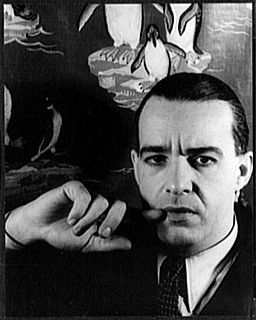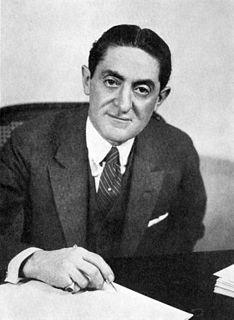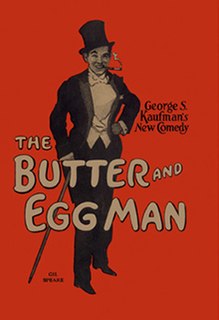Related Research Articles

George Simon Kaufman was an American playwright, theatre director and producer, humorist, and drama critic. In addition to comedies and political satire, he wrote several musicals for the Marx Brothers and others. He won the Pulitzer Prize for Drama for the musical Of Thee I Sing in 1932, and won again in 1937 for the play You Can't Take It with You. He also won the Tony Award for Best Director in 1951 for the musical Guys and Dolls.

Moss Hart was an American playwright and theater director.

Alfred Davis Lunt Jr. was an American stage director and actor who had a long-time professional partnership with his wife, actress Lynn Fontanne. Broadway's Lunt-Fontanne Theatre was named for them. Lunt was one of 20th century Broadway's leading male stars.

Merrily We Roll Along is a play by George S. Kaufman and Moss Hart. It concerns a man who has lost the idealistic values of his youth. Its innovative structure presents the story in reverse order, with the character regressing from a mournful adult to a young man whose future is filled with promise.

Lynn Fontanne was a British actress. She teamed with her husband, Alfred Lunt. Lunt and Fontanne were given special Tony Awards in 1970. They both won Emmy Awards in 1965, and Broadway's Lunt-Fontanne Theatre was named for them. Fontanne is regarded as one of the American theater's great leading ladies of the 20th century.

Uta Thyra Hagen was a German-American actress and theatre practitioner. She originated the role of Martha in the 1962 Broadway premiere of Who's Afraid of Virginia Woolf? by Edward Albee, who called her "a profoundly truthful actress". Because Hagen was on the Hollywood blacklist, in part because of her association with Paul Robeson, her film opportunities dwindled and she focused her career on New York theatre.

Jubilee is a musical comedy with a book by Moss Hart and music and lyrics by Cole Porter. It premiered on Broadway in 1935 to rapturous reviews. Inspired by the recent silver jubilee of King George V of Great Britain, the story is of the royal family of a fictional European country. Several of its songs, especially "Begin the Beguine" and "Just One of Those Things", became independently popular and have become part of the American Songbook.

The Man Who Came to Dinner is a comedy play by George S. Kaufman and Moss Hart. It debuted on October 16, 1939, at the Music Box Theatre in New York City, where it ran until 1941, closing after 739 performances. It then enjoyed a number of New York and London revivals. The first London production was staged at The Savoy Theatre starring Robert Morley and Coral Browne. In 1990, Browne stated in a televised biographical interview, broadcast on UK Channel 4, that she bought the rights to the play, borrowing money from her dentist to do so. When she died, her will revealed that she had received royalties for all future productions and adaptations.

Fanny is a musical with a book by S. N. Behrman and Joshua Logan and music and lyrics by Harold Rome. A tale of love, secrets, and passion set in and around the old French port of Marseille, it is based on Marcel Pagnol's trilogy of works titled Marius (1929), Fanny (1931), and César (1936).

Face the Music is a musical, the first collaboration between Moss Hart (book) and Irving Berlin. Face the Music opened on Broadway in 1932, and has had several subsequent regional and New York stagings. The popular song "Let's Have Another Cup of Coffee" was introduced in the musical by J. Harold Murray.

As Thousands Cheer is a revue with a book by Moss Hart and music and lyrics by Irving Berlin, first performed in 1933. The revue contained satirical sketches and witty or poignant musical numbers, several of which became standards, including "Heat Wave", "Easter Parade" and "Harlem on my Mind". The sketches were loosely based on the news and the lives and affairs of the rich and famous, and other people of the day, such as Joan Crawford, John D. Rockefeller, Jr., Noël Coward, Josephine Baker, and Aimee Semple McPherson.
Diane Marie Paulus is an American theatre and opera director who is currently the Terrie and Bradley Bloom Artistic Director of the American Repertory Theater at Harvard University. Paulus was nominated for the Tony Award for Best Direction of a Musical for her revivals of Hair and The Gershwins' Porgy and Bess, and won the award in 2013 for her revival of Pippin.

Once in a Lifetime is a play by Moss Hart and George S. Kaufman, the first of eight on which they collaborated in the 1930s.

Of Mice and Men is a play adapted from John Steinbeck's 1937 novel of the same name. The play, which predates the Tony Awards and the Drama Desk Awards, earned the 1938 New York Drama Critics' Circle Best Play.

Sam Henry Harris was a Broadway producer and theater owner.
Act One is a play written by James Lapine, based on Moss Hart's 1959 autobiography of the same title. The play premiered on Broadway in 2014.

Jay Velie was an American actor and singer; he appeared in many Broadway shows during a career that spanned more than fifty years. He also appeared in a few film shorts.

The Butter and Egg Man is a 1925 play by George S. Kaufman, the only play he wrote without collaborating. It was a Broadway hit during the 1925–26 season at the Longacre Theatre. Adapted to film six times, it is still performed on stages today.
The American Way is a play by American playwrights George S. Kaufman and Moss Hart.
Stage Door is a 1936 stage play by Edna Ferber and George S. Kaufman about a group of struggling actresses who room at the Footlights Club, a fictitious theatrical boardinghouse in New York City modeled after the real-life Rehearsal Club. The three-act comedy opened on Broadway on October 22, 1936, at the Music Box Theatre and ran for 169 performances. The play was adapted into the 1937 film of the same name, and was also adapted for television.
References
- ↑ "'The Fabulous Invalid,'" The New York Times 30 Oct. 1938.
- 1 2 Atkinson, Brooks. "Moss Hart and George Kaufman Celebrate the Theatre in 'The Fabulous Invalid,' The New York Times 10 Oct. 1938.
- ↑ Meredith, Scott. George S. Kaufman and His Friends. Garden City: Doubleday & Company, 1974. 548.
- 1 2 3 Brown, Jared. Moss Hart: A Prince of the Theatre. New York: Back Stage, 2006. 150-2.
- ↑ Goldstein, Malcolm. George S. Kaufman: His Life, His Theater. New York: Oxford University Press, 1979. 309.
- 1 2 Bach, Steven. Dazzler: The Life and Times of Moss Hart. New York: Da Capo, 2001. 168-9.
- ↑ Reed, Edward. "Two Lost Opportunities," The Washington Post 5 Feb. 1939.
- 1 2 Siegel, Ed. "A quick-witted gift for the Majestic's 100th," The Boston Globe 19 Nov. 2003.
- ↑ "'Fabulous Invalid,'" The New York Times 21 Apr. 1940.